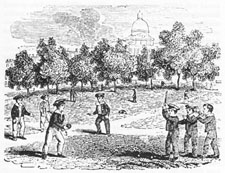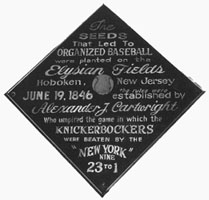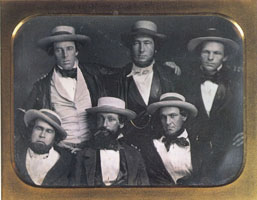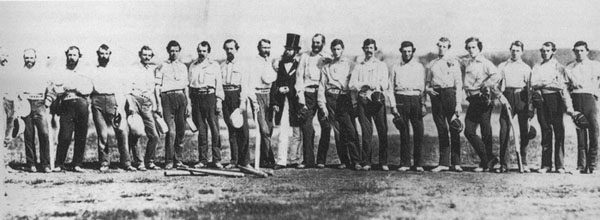 The myth of baseball -- that it is a pastoral game, linking Americans to a simpler, agrarian past -- does not entirely hold. Baseball's ancestry lies in the British games of cricket, a ceremonious, white-collar pastime, and rounders, a children's game translated to New England by early colonists. But the direct parent of baseball was played by a group of gentlemen in Manhattan, beginning in 1842.
The myth of baseball -- that it is a pastoral game, linking Americans to a simpler, agrarian past -- does not entirely hold. Baseball's ancestry lies in the British games of cricket, a ceremonious, white-collar pastime, and rounders, a children's game translated to New England by early colonists. But the direct parent of baseball was played by a group of gentlemen in Manhattan, beginning in 1842.
 On September 23, 1845, twenty-eight men made up of merchants, brokers, salesmen -- "men who were at liberty after 3 o'clock in the afternoon"1 -- formed the New York Knickerbocker Base Ball Club. As Manhattan continued to grow and suitable space evaporated, the Knickerbockers began taking the ferry across the Hudson River to Hoboken. They played on weekends and practiced twice a week on their new grounds, Elysian Fields, which were conveniently lined not only with trees, but taverns as well. On June 19, 1846, the Knickerbockers' second team lost 23-1 to the New York Base Ball Club in the first official, prearranged match between two clubs.
On September 23, 1845, twenty-eight men made up of merchants, brokers, salesmen -- "men who were at liberty after 3 o'clock in the afternoon"1 -- formed the New York Knickerbocker Base Ball Club. As Manhattan continued to grow and suitable space evaporated, the Knickerbockers began taking the ferry across the Hudson River to Hoboken. They played on weekends and practiced twice a week on their new grounds, Elysian Fields, which were conveniently lined not only with trees, but taverns as well. On June 19, 1846, the Knickerbockers' second team lost 23-1 to the New York Base Ball Club in the first official, prearranged match between two clubs.
 The National Association of Base Ball Players was formed in 1857 by the Knickerbockers and fifteen other clubs, to promote and regulate the game. Baseball, though first dubbed the "National Pastime" by the New York Mercury on December 5, 1856, was still a New York phenomenon. But, it was vastly popular there. By 1858, trains were being run to the Fashion Race Course on Long Island to witness games. It was there that 4,000 spectators watched the New York All-Stars defeat Brooklyn two games out of three. The owner of the fields charged each 50 cents admission -- the first time spectators paid to watch the game.
The National Association of Base Ball Players was formed in 1857 by the Knickerbockers and fifteen other clubs, to promote and regulate the game. Baseball, though first dubbed the "National Pastime" by the New York Mercury on December 5, 1856, was still a New York phenomenon. But, it was vastly popular there. By 1858, trains were being run to the Fashion Race Course on Long Island to witness games. It was there that 4,000 spectators watched the New York All-Stars defeat Brooklyn two games out of three. The owner of the fields charged each 50 cents admission -- the first time spectators paid to watch the game.
By 1860, sixty clubs had joined the Association, including teams from as far west as Chicago and St. Louis. The Civil War served to spread the game throughout the South, as Northerns taught Confederates the game in prison camps. New clubs continued to come into existence, and good players were courted and even paid. Yet, in spite of this "creeping capitalism," "professional players and member-owners seemed to enjoy an artist-patron relationship"2 as the notion of gentlemanly amateurism persisted. However, as rules changed and the game increasingly demanded skill and athleticism, the disparity between amateur and professional players increased. The Knickerbockers' invention of 1845 had evolved to something quite different by 1869.
1 Geoffrey C. Ward, Baseball: An Illustrated History (New York: Knopf, 1994) 4.
2 David Quentin Voigt, Baseball: An Illustrated History (University Park: Pennsylvania State UP, 1987) 20.
 Elysian Fields
Elysian Fields
 Elysian Fields
Elysian Fields
